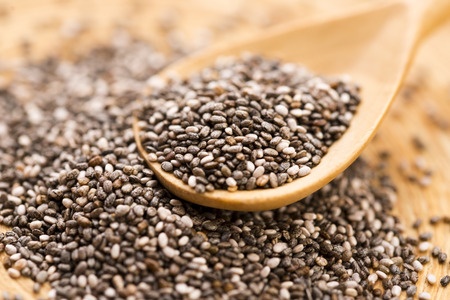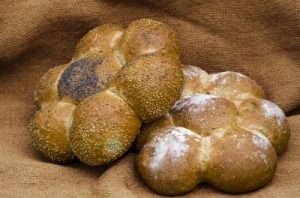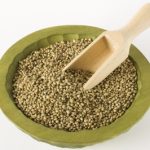
Chia seeds seem to be all the rage in nutrient circles at the moment, appearing in a range of products, such as the Smooch™ range and claiming to be one of the richest sources of omega-3 fatty acids. Their presence is very exciting for those product developers seeking alternatives to other fatty acid rich ingredients. It is marketed as an ‘ancient grain’ along with quinoa for example as both have an ancient history of use. Chia as a food ingredient has been used by the ancient Aztecs and Mayans, the native American Indians and rural Mexicans for centuries as these black seeds are good sources of protein and fibre. The Nahua races of ancient Mexico cultivated the plants in the same fields as corn and were essential in the diet (Parsons, 1955).
Chia (Salvia hispanica L.) is grown commercially primarily for its oil content which is extracted on a grand industrial scale. It is often described as an oilseed and is a plant in the Labiatae family. It is mostly cultivated in various parts of the Americas, the West Indies and the Caribbean, Southeast Asia and now Australia (Ayerza and Coates, 2005).
Chia seeds are obtained from a variety of Salvia (sage family) plants such as S. hispanica L., S. columbria Benth. S. polystachya and others in the family Labiatae.
Chia Seeds In Foods

For the product developer, chia could well be the success story as it works well in grain-centered bakery products like bread, cakes, cookies, breakfast cereals, nutrition bars, salad dressings, and chowder/soup. Chia seeds are popular additions to fruit, seed and nut bars such as those offered by 9Bar. Their flavour is nutty with cereal overturns. They are often sprinkled on shakes, muesli and smoothies.
It has excellent gelling properties which makes it feasible in a number of applications not usually open to cereals. Chia has been used for this particular functional property in flavoured milks and smoothies, fruit juices, salad dressings, yoghurts, some soups, condiments and sauces. The seed has also been reconstituted in sports beverages to combat muscle soreness and inflammation, and aid muscle recovery. One other interesting fact; it contains more fat than cereal grains and has been demonstrated to be an effective egg or oil replacer in a variety of baked products. An ideal ingredient then for vegan cooking.
The oil has wide application in cosmetics. The seed is extensively reviewed in the journals – see Ali et al., 2012 and Muñoz et al. 2013 as two good examples.
Delicious Ways To Eat Chia Seeds
- If you like cereals for breakfast then try chia seeds in your oat recipes, especially in porridge. Two tablespoons is enough to give you that nutritional punch without altering the thickness or consistency of your soups, porridges and other foods.
- Try them in soups, oatmeal dishes and of course smoothies. They add a slight crunch and an interesting bite to any dish
- A chia gel is produced by mixing a 1/4 cup of chia seed with a full cup of any liquid food. The gel serves as a drink in its own right and encourages feelings of being full in the stomach.
Nutritional Value Of Chia Seeds
The seed has a high protein content of 19.0 to 25.0 per cent when compared to other grains. Oats are 15.3%, wheat and maize are 14.0%, barley is 9.2% and finally rice is 8.5% protein. The remaining nutrients in seed include 30-33% oil and fats (both omega-3s and 6s), especially α-linolenic fatty acid (60% to 68%) (Ixtaina et al., 2011) and 26-41% carbohydrates.
The US Department of Agriculture (USDA) National Nutrient Database defines the nutritional content of a 28 gram or one ounce serving of chia seeds as the following:-
- 131 calories
- 13.1 grams of carbohydrates
- 8.4 grams of fat
- 11.2 grams of fibre (fiber)
- 5.6 grams of protein
- no sugars
- calcium – provides 18 percent of dietary requirements
- phosphorous – provides 27 percent of dietary requirements
- manganese – provides 30 percent of dietary requirements
- some copper and potassium
Chia seeds could provide approximately 13%, 29% and 2% of the Recommended Dietary Allowance (RDA) for niacin, thiamine and riboflavin respectively (Bushway et al., 1981). It is high in minerals like calcium, potassium, magnesium, fibre, protein and various antioxidants and in keeping with non-cereal grains, is gluten-free too. we can also see that chia is a great source of manganese, copper and molybdenum. Compared to flax seed and perilla seed, which are both important sources of omega-3 oils, chia is thought to have the advantage because it can be ground to a meal without the risk of rancidity of the omega-3 oils because of the higher antioxidant content. The main antioxidants are chlorogenic acid, kaempferol, myricetin, caffeic acid and quercetin.
Health Benefits Of Chia Seeds
Therapeutic benefits for chia seeds are many (Parker et al., 2018). The focus is on the high proportion of alpha-linolenic acid that makes this seed such an excellent source of omega-3 fatty acids. This fatty acid is strongly associated with a variety of physiological and biochemical functions in the body. The seed is used in the “control of diabetes, dyslipidaemia, hypertension, as anti-inflammatory, antioxidant, anti-blood clotting, laxative, antidepressant, anti-anxiety, analgesic, vision and immune improver” according to a review by Ullah et al., (2016).
Poudyal et al., (2012) showed feeding chia seeds in a rat model helped with lipid redistribution which was associated with both heart and liver health. The diets were supplemented for 8 weeks with 5%w/w chia seeds following an 8-week diet rich in carbohydrates and fat. Those rats fed chia seed had better insulin sensitivity and glucose tolerance, lower liver steatosis, and lower cardiac and liver inflammation with no change in either plasma lipid contents or blood pressure.
Chia Seeds And Diabetes
Consumption of the seeds is associated with better control of post-prandial glycemia in type-2 diabetes patients (Ho et al., 2013).
In terms of general health in postmenopausal women, there is an improved lipid profile of the blood in terms of their alpha-linolenic acid (ALA) and eicosapentanoic acid profiles (EPA) (Jin et al., 2010).
Anticancer Activity
A recent study indicates that protein fractions from chia seed have potent anticancer activity. An hydrolysate from chia was ultrafiltered and then evaluated on four cancer cell lines and on human fibroblasts (hFB) at various concentrations. None of the protein fractions showed toxicity towards the fibroblasts. One particular peptide KLKKNL appeared to have significant potential.
Chia Seeds And Food Satiety
Chia seeds in yogurt were fed as a mid-morning snack to 24 participants. The subjects received either yogurt with no seeds, or yogurt with 7 g of seeds or 14 g of seeds. The subjects consuming the chia seeds reported less desire for sugary foods, greater feelings of fullness and their energy consumption was lower (Ayaz et al., 2017). There is a contradictory study though with overweight adults which found consumption of 25 g of chia seeds daily did not encourage weight reduction or even improve the risk factors associated with various diseases (Nieman et al., 2009).
Chia Seeds And Heart Health
The alpha-linolenic acid (ALA) content is an important factor in overall heart health. This fatty acid, ALA is converted to two important omega-3 fatty acids – docosahexaenoic acid (DHA) and eicosapentaenoic acid (EPA). It’s not entirely clear how these two dietary fatty acids affect heart health but they are absolutely essential for a healthy heart.
Chia Seed Consumption And Osteoporosis
Whilst it is a rat study, a long-term examination of seed intake showed an association with improved bone mineral content (BMC) and positive correlations with skeletal weight, final body weight and skin weight. There were also lower lipid amounts in liver cells and better ‘structure’ in the intestinal wall (Montes Chañi et al., 2018). There is potential here for consumption to be a possible route to ameliorating the loss of bone mineral density (BMD) in osteoporosis however a number of solid clinical studies will be needed to establish this association.
Sources Of Chia Seeds
Chia seed is readily obtainable from a number of sources. BI Nutraceuticals (Long Beach, California) have steam-sterilised chia seed to extend its shelf-life. At one SupplySide West show, BI Nutraceuticals offered a brownie composed of chia seed which contained less than 50% fat compared to the typical counterpart with 250mg serving of omega-3 fatty acids. They also offer a meal made from the seed. Proprietary Nutritionals Inc. too, offer chia seed under the BeneXia® brand logo as well as the flour, encapsulated oil from chia and a bulk oil
We can also recommend brands from Europe such as Nature’s Heart, Sevenhills, and from The Little Seed Co.
[Please note we are an affiliate marketing partner and will make a sales commission if you purchase any items through our affiliate links. Please read our affiliate disclosure]
Chia Seed Oil
Cold pressed chia oil is extremely rich in polyunsaturated fatty acids, especially omega-3 linolenic acid. In fact, it is the richest botanical source of 18:3 n-3 fatty acids known (Ayerza & Coates, 2007). Their oil content, about 30% in total with 90% triglycerides was examined in the mid-20th Century (Palma et al., 1947; Earle et al., 1960). The main components are linoleic (17-26%) and linolenic acid (50-57%) acids. This component would lend itself very effectively to supplementation in many processed foods needing omega-3 or-6 fatty acids (Dubois et al., 2007).
The oil was discovered by researchers at the Department of Medicine in Korea University of Medicine and found to be a skin improver (Jeong et al., 2010). The study examined topical application of chia seed oil over an 8-week period demonstrating reduction in skin itchiness (pruritus), better skin hydration and its barrier maintenance. Sensory work suggests it would be an excellent addition to the range of oils used for skin lotions, especially for dry, aged and mature, or sensitive skin. Seatons (part of Croda International Plc.) produce a chia seed oil suited to personal care applications.
Chia Seeds And Animal Feed
Chia seeds and the seed oil have been fed to laying hens where they improved the omega-3 fatty acid content of eggs (Antruejo et al., 2011).
Potential Value In Chia Seeds
The extraction process generates plenty of seed meal which is a by-product rich in protein and dietary fiber. The proteins are mainly globulins (52%) made up of 11S and 7S types. Within this group are albumins, globulins, prolamins and glutelins. Analysis of the amino-acid composition indicates this protein is a good source of essential amino acids, especially methione and cysteine (Sandoval-Oliveros and Paredes-Lopez, 2013).
Bioactive peptides could be extracted on a major scale from this meal. One study has used chia seed meal as a source of protein hydrolysate which could compete with whey hydrolysate as a food source of protein. The peptide sequences have been characterized using a range of proteases such as pepsin. What prompted such interest from these hydrolysates was their potential as peptide to reduce blood pressure (antihypertensive agent).
The pepsin derived protein hydrolysate had the highest angiotensin-converting enzyme inhibition potential with an IC50 of 0.128 mg/ml.
Regulatory Approval
The European Commission classifies chia seed as a novel food according to regulation (EU) 2015/2283. It is also considered safe to use and there is no maximum intake level cited (EFSA, 2019). However it does claim to restrict chia seed to 15g/day for the addition of whole, mashed or ground chia seeds in fruit juice and fruit/vegetable blend beverages. This had already been outlined in current EU legislation.
The European Food Safety Authority (EFSA) advise the use of chia oil to be safe at a maximum level of 2 g per day. It also rejects concerns over contaminant formation.
The only concern raised by safety experts concerned a possible rise in acrylamide levels as a process contaminant. It is thought to form when chia seeds are subject to heat treatment of 120 degrees Centigrade and above.
Amendments
New material added on anticancer properties of Chia protein fractions -original was 20th May 2021.
References
Ali, N.M., Yeap, S.K., Ho, W.Y., Beh, B.K., Tan, S.W. and Tan, S.G. (2012) The promising future of chia, Salvia hispanica L. J. Biomedicine and Biotechnology, Article ID: 171956.
Antruejo, A., Azcona, J.O., Garcia, P.T., Gallinger C, Rosmini M, Ayerza R, Coates W, Perez CD. (2011) Omega-3 enriched egg production: the effect of a-linolenic ω-3 fatty acid sources on laying hen performance and yolk lipid content and fatty acid composition. British Poult Sci. 52 pp. 750–60.
Ayaz, A., Akyol, A., Inan-Eroglu, E., Kabasakal Cetin, A., Samur, G., & Akbiyik, F. (2017). Chia seed (Salvia Hispanica L.) added yogurt reduces short-term food intake and increases satiety: randomised controlled trial. Nutrition Research and Practice, 11(5), pp. 412-418.
Ayerza, R., Coates, W. (2005) Chia: rediscovering a forgotten crop of the aztecs. The Tucson, AZ, U.S.A.: University of Arizona Press.
, , , & ( 2017). Chia (Salvia hispanica L.) oil stability: Study of the effect of natural antioxidants. LWT – Food Science and Technology, 75, pp. 107– 113 (Article)
Bordón, M. G., Meriles, S. P., Ribotta, P. D., & Martinez, M. L. (2019). Enhancement of Composition and Oxidative Stability of Chia (Salvia hispanica L.) Seed Oil by Blending with Specialty Oils. Journal of Food Science. (Article)
Bushway, A.A., Belyea, P.R., Bushway, R.J. (1981) Chia Seed as a source of oil, polysaccharide, and protein. J. Food Sci. 46 pp. 1349-1350, 1356
Dubois, V., Breton, S., Linder, M., Fanni, J., Parmentier, M. (2007) Fatty acid profiles of 80 vegetable oils with regard to their nutritional potential. Eur. J. Lipid Sci. Technol. 109(7) pp. 710–732.
Earle, F.R., McGuire, T.A., MaBan, J., Bagby. M.O., Wolf, I.A.(1960) Search for new industrial oils. 2. Oils with high iodine values. J. Am. Oil Chem. 37 pp. 48.
EFSA Panel on Nutrition, Novel Foods and Food Allergens (EFSA NDA Panel), Turck, D., Castenmiller, J., de Henauw, S., Hirsch‐Ernst, K. I., Kearney, J., … & Pelaez, C. (2019). Safety of chia seeds (Salvia hispanica L.) as a novel food for extended uses pursuant to Regulation (EU) 2015/2283. EFSA Journal, 17(4), e05657.
Ho H, Lee AS, Jovanovski E, Jenkins AL, Desouza R, Vuksan V. (2013) Effect of whole and ground Salba seeds (salvia Hispanica L.) on postprandial glycemia in healthy volunteers: a randomized controlled, dose-response trial. Eur. J. Clin. Nutr. 67 pp. 786–8.
Ixtaina, V.Y., Martínez, M.L., Spotorno, V., Mateo, C.M., Maestri, D.M., Diehl, B.W.K., Nolasco, S.M., Tomás, M.C. (2011). Characterization of chia seed oils obtained by pressing and solvent extraction. J. Food Compos. Anal. 24(2) pp. 166–74.
Jeong, S.K., Park, H.J., Park, B.D., Kim, I-H. (2010) Effectiveness of Topical Chia Seed Oil on Pruritus of End-stage Renal Disease (ESRD) Patients and Healthy Volunteers. Ann. Dermatol. 22(2) pp. 143-148
Jin, F., Nieman, D.C., Sha, W., Xie, G., Qiu, Y., Jia, W. (2010) Supplementation of milled chia seeds increases plasma ALA and EPA in postmenopausal women. Plant Foods Hum Nutr. 67 pp. 105–10.
Imran, M., Nadeem, M., Manzoor, M. F., Javed, A., Ali, Z., Akhtar, M. N., … & Hussain, Y. (2016). Fatty acids characterization, oxidative perspectives and consumer acceptability of oil extracted from pre-treated chia (Salvia hispanica L.) seeds. Lipids in Health and Disease, 15(1), pp. 162.
Levent, H. (2017). Effect of partial substitution of gluten-free flour mixtures with chia (Salvia hispanica L.) flour on quality of gluten-free noodles. Journal of Food Science and Technology, 54(7), pp. 1971-1978.
, , , , , & ( 2012). Chia (Salvia hispanica L.) oil extraction: Study of processing parameters. LWT – Food Science and Technology, 47( 1), pp. 78– 82.
Montes Chañi, E., Pacheco, S., Martínez, G., Freitas, M., Ivona, J., Ivona, J., … & Pacheco, F. (2018). Long-Term Dietary Intake of Chia Seed Is Associated with Increased Bone Mineral Content and Improved Hepatic and Intestinal Morphology in Sprague-Dawley Rats. Nutrients, 10(7), pp. 922.
Muñoz, L.A., Cobos, A., Diaz, O., Aguilera, J.M. (2013) Chia Seed (Salvia hispanica): An Ancient Grain and a New Functional Food, Food Rev. Int., 29, 4, p. 394
Nieman, D.C., Cayea, E.J., Austin, M.D., Henson DA, McAnulty SR, Jin F. (2009) Chia seed does not promote weight loss or alter disease risk factors in overweight adults. Nutr. Res. 29 pp. 414–8.
Palma, F.. Donde, M.. Lloyd, W.R. (1947) Fixed oils of Mexico. 1. Oil of chia-Salvia hispanica. J. Am. Oil Chem. 24 pp. 27
Parker, J., Schellenberger, A. N., Roe, A. L., Oketch-Rabah, H., & Calderón, A. I. (2018). Therapeutic perspectives on chia seed and its oil: A review. Planta Medica, 84(09/10), pp. 606-612.
Parsons, M.E. (1955) “The Wild Flowers of California.” Calif. Acad. Sci.. San Francisco, CA. USA.
Poudyal, P., Panchal, S.K., Waanders, J., Ward, L. Brown, L. (2012) Lipid redistribution by alpha-linolenic acid-rich chia seed inhibits stearoyl-CoA desaturase-1 and induces cardiac and hepatic protection in diet-induced obese rats. J. Nutr. Biochem. 23 pp. 153–62
Quintal‐Bojórquez, N. D. C., Carrillo‐Cocom, L. M., Hernández‐Álvarez, A. J., & Segura‐Campos, M. R. (2021). Anticancer activity of protein fractions from chia (Salvia hispanica L.). Journal of Food Science. 86 (7) pp. 2861-2871
Sandoval-Oliveros, M.R. Paredes-Lopez, O. (2013) isolation and characterization of proteins from chia seeds (Salvia hispanica L.). J. Agric. Food Chem., 61(1) pp. 193-201 (Article)
Ullah, R., Nadeem, M., Khalique, A., Imran, M., Mehmood, S., Javid, A., & Hussain, J. (2016). Nutritional and therapeutic perspectives of Chia (Salvia hispanica L.): a review. Journal of Food Science and Technology, 53(4), pp. 1750-1758 (Article).
Weber, C. W., H. S. Gentry, E. A. Kohlhepp, and P. R. McCrohan.(1991) The nutritional and chemical evaluation of chia seeds. Ecol. Food Nutr. 26 pp. 119–125.

Very good seeds for baking with. I have them at breakfast now with almond milk which I think is why I am feeling so much better in the morning. I know reading other comments that they help fill you up and I reckon they are dosing exactly the same for me. I just do not feel so hungry in the middle of the morning. More power to chia I think.